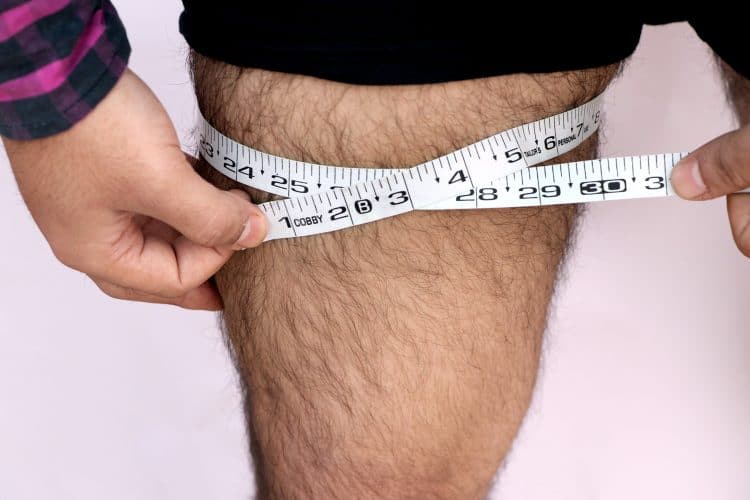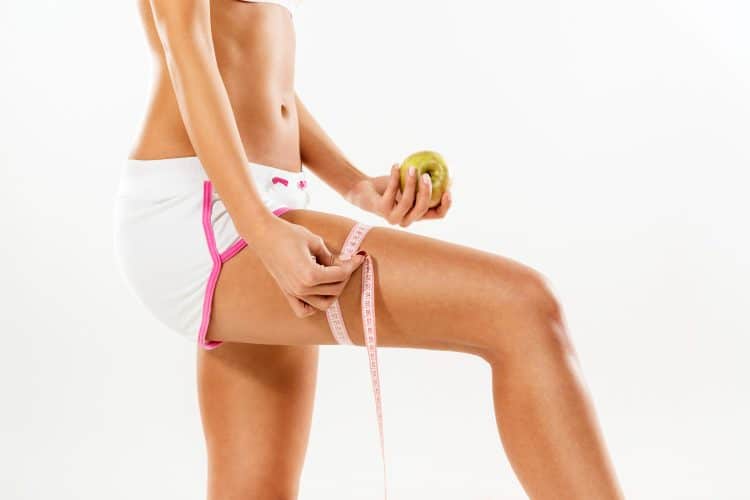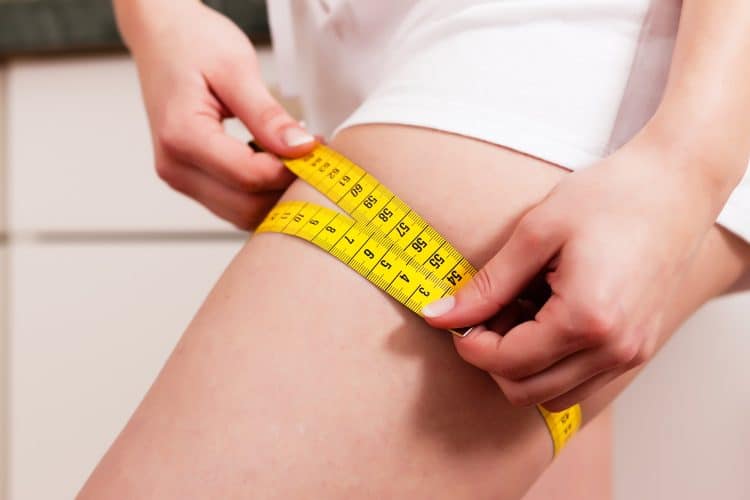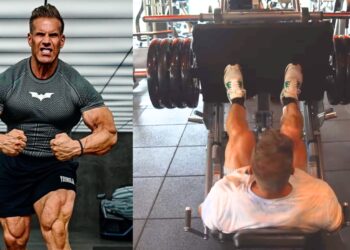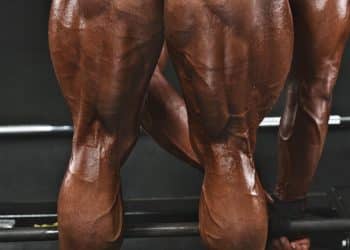Sculpted legs are what separate the men from the boys. It doesn’t matter how jacked your upper body is, if you have skinny legs, you might be subjected to ridicule by your friendly neighborhood gym bros. No one wants to be called chicken legs, after all.
If you can’t still find the motivation to train, what you’re about to read next might change your mind.
As per a study, small thigh circumference has been associated with diabetes among men and women. Furthermore, this relationship was stronger among participants younger than 50 years. [1]
But why are people with smaller thigh circumference at greater risk, you ask?
While more research is needed to establish a solid cause and effect relationship, people with smaller legs likely lack the muscle mass and bulk necessary to ensure proper glucose and lipid metabolism, which are key factors for more serious diseases.
In a study conducted on 324 women over 12 years, it was found that stronger legs were associated with higher cognitive scores and IQs. [2]
Level Up Your Fitness: Join our 💪 strong community in Fitness Volt Newsletter. Get daily inspiration, expert-backed workouts, nutrition tips, the latest in strength sports, and the support you need to reach your goals. Subscribe for free!
In this article, you’ll learn about the average thigh circumference in males and females, how to measure your thighs correctly, and what you can do to add or reduce your upper leg size.
What is the average thigh circumference for a male?
| Age | Thigh Size (inches) |
| 20-29 | 20.8 |
| 30-39 | 21.3 |
| 40-49 | 21.4 |
| 50-59 | 20.9 |
| 60-69 | 20.6 |
| 70-79 | 19.5 |
| 80+ | 18.7 |
As per the data from the Centers for Disease Control and Prevention (CDC), based on 4,255 subjects, the average male thigh size is 21.2 inches or 53.8 cm. [3]
Furthermore, an average man aged between 20 and 29 had 20.8-inch thighs, while men aged between 30 to 39 had 21.3-inch upper legs. Per the study, the average male thigh size peaks at 21.4 inches between the ages of 40 and 49.
The upper leg size of an average male drops to 20.9 inches in the 50 to 59 age range and further reduces to 20.6 inches in the 60 to 69 age bracket.
The average male thigh size continues its downward spiral and falls to 19.5 inches for men between the ages of 70 and 79 and drops to 18.7 inches for men over 80.
What is the average thigh size for an adolescent boy?
| Age | Thigh Size (inches) |
| 8 years | 15.1 |
| 9 years | 15.7 |
| 10 years | 16.6 |
| 11 years | 17.4 |
| 12 years | 18.1 |
| 13 years | 18.9 |
| 14 years | 19.4 |
| 15 years | 20.2 |
| 16 years | 21.1 |
| 17 years | 21 |
| 18 years | 21.1 |
| 19 years | 21.6 |
The average thigh size for an average adolescent boy increases every year between the age of eight and 16. However, the upper leg size stalls for the next couple of years before continuing the upward trend as they turn 19.
What is the average thigh circumference for a female?
| Age | Thigh Size (inches) |
| 20-29 | 21.7 |
| 30-39 | 21.7 |
| 40-49 | 21.7 |
| 50-59 | 20.9 |
| 60-69 | 20.4 |
| 70-79 | 19.7 |
| 80+ | 18.3 |
According to the same CDC survey mentioned above, based on a sample size of 4,065 women, the average thigh circumference for a female is 20.8 inches. [3]
Although the female upper leg size changes with age, it remains relatively stable until their 50s. After peaking at 21.7 inches at 20, the average thigh size remains unchanged until a woman turns 50.
The average female upper leg size undergoes a big drop to 20.9 inches in the 50 to 59 age bracket. It further falls to 20.4 inches when a woman is between 60 and 69.
On average, the drop in thigh circumference continues as it falls to 19.7 inches as a woman enters her 70s. It further decreases to 18.3 inches as a woman turns 80.
What is the average thigh size for an adolescent girl?
| Age | Thigh Size (inches) |
| 8 years | 15 |
| 9 years | 16.1 |
| 10 years | 17 |
| 11 years | 18 |
| 12 years | 18.3 |
| 13 years | 19.1 |
| 14 years | 19.3 |
| 15 years | 19.6 |
| 16 years | 19.7 |
| 17 years | 20.4 |
| 18 years | 20.5 |
| 19 years | 20.6 |
The average upper leg size of an adolescent girl is quite similar to that of a boy. However, girls usually have bigger thigh circumference than boys until they are 13 — probably because they begin puberty before boys.
While boys take the lead when they turn 14, they again find themselves in the back seat when they turn 20.
Comparison Between Average Thigh Circumference in Males and Females
Interestingly, on average, females between the age of 20 and 49 have bigger thighs than their male counterparts. Men catch up to women in the 50 to 59 age bracket and briefly outsize them in the 60 to 69 age range before giving up the lead in their 70s. However, as per the survey, men end strong with an 18.7-inch thigh circumference compared to an 18.3-inch measurement for women.
Level Up Your Fitness: Join our 💪 strong community in Fitness Volt Newsletter. Get daily inspiration, expert-backed workouts, nutrition tips, the latest in strength sports, and the support you need to reach your goals. Subscribe for free!
How to measure your thigh circumference?
This is how to measure your upper leg size correctly:
- Stand upright with a slightly wider-than shoulder-wide stance.
- Flex your quad and wrap a soft tape measure around the thickest part of your upper leg, typically in the upper half of your leg.
- Make sure your leg is exposed, and you’re not measuring your thigh size over a piece of clothing.
- The tape should be flush against your skin and not pulling into your leg.
- Check where the tape overlaps and record your thigh circumference.
How to measure your thigh circumference for bodybuilding?
Tracking your body measurements is one of the most effective ways of assessing the effectiveness of your training and diet program.
While the actual process of thigh size measurement remains the same for a bodybuilder and a person not into lifting weights, here are a few things a lifter should consider:
1. Measure Your Quads While Pumped
While you could measure your quads cold (without a pump), the industry-standard practice is to measure your thighs with a pump after a leg workout.
However, knowing your upper leg measurement with and without a pump gives you a better idea of your upper leg musculature.
2. Hamstrings are as Important as Quads in Measuring Thigh Circumference
If you want a bigger thigh circumference, you need to work on your hamstrings just as hard. Remember, the tape measure will wrap around your entire upper leg and not just your quad.
Additionally, while measuring your thigh circumference, wrap the tape around the thickest part of your hamstring and quad. Do not worry if the tape is skewed while taking the measurement.
How to Increase Your Thigh Circumference?
If you’re lagging in the upper leg department and want to put on size, here is how to do it:
1. Follow an Effective Leg Training Program
If you want to add meat to your skinny legs, you should follow a hypertrophy-focused training program. Plus, you should divide your leg workouts into two different days — quads and hamstrings.
Train your legs twice a week and perform at least eight to 12 reps on each exercise. Make sure you are contracting your target muscles with every repetition.
Here are a couple of workouts you can try the next time you’re in the gym:
Quad-Focused Leg Workout
- Front Squat: 3 x 8-12
- Leg Extension: 3 x 8-12
- Sissy Squat: 3 x 8-12
- Leg Press: 3 x 8-12
- Heels Elevated Goblet Squat: 3 x 8-12
Hamstring-Focused Leg Workout
- Lying Leg Curl: 3 x 8-12
- Romanian Deadlift: 3 x 8-12
- Good Morning: 3 x 8-12
- GHD: 3 x 8-12
- Hip Thrust: 3 x 8-12
2. Eat a High-Protein Diet
To pack on size, you need to eat a nutrient-dense diet. Figure out your daily calorie target and macronutrient break-up, and design a diet that suits your lifestyle.
3. Focus on Recovery
It doesn’t matter how hard you work in the gym if you’re not allowing your body rest to recuperate from your workouts. You should be sleeping anywhere between six to eight hours a night and using supplements to speed up your recovery process.
How to Reduce Your Thigh Circumference?
Depending on your current situation, here’s how to reduce your upper leg size:
1. You Have Lower Body Fat
If you want to shed lower body size, you’ll have to begin by cutting calories. Plus, you’ll need to add cardio to your training routine to ensure you’re in a calorie deficit.
2. Your Legs are Too Muscular
You are the envy of the average gym bro if you have too much muscle mass on your legs and want to shed some to improve your physique’s aesthetics.
If your legs are genetically more muscular, you’ll have a hard time reducing your thigh circumference. Apart from lowering your calorie intake, you might have to stop training your legs and add low-intensity steady-state (LISS) cardio to your routine.
Related: HIIT vs. LISS Cardio: Which One Is Best for Fitness and Fat Loss?
FAQs
Where should you measure your thigh?
The point where you should wrap the measuring tape will be different for different people. Depending on your musculature, select the area where your leg is the thickest. Also, make sure you measure both your legs.
How to find the thickest part of my upper leg?
If you can’t figure out where your upper leg is the thickest by looking at it, feel free to measure your thigh at different points and record the measurement where it is the biggest.
What should be my thigh size as per my height?
Currently, there is not enough research to answer this question. However, on average, taller people usually have slimmer thigh circumference than their shorter counterparts (in the same age group) as the muscle mass is stretched over a larger surface area.
My thighs are smaller (or bigger) than the average thigh circumference for my age. Should I be worried?
You shouldn’t be worried if your upper legs are smaller or bigger by an inch than the average for your age. However, you can fix the size discrepancies by following the steps mentioned in this article.
You might also like:
- Average Waist Size For Women and Men
- Average Calf Size for Men and Women
- Average Biceps Size: How Do You Measure Up?
Wrapping Up
The average thigh circumference in males and females would surely have surprised many folks who were expecting men to outsize their counterparts by a margin.
While there isn’t much you can do about evolution, genetics, and statistics, you could change (increase or decrease) the size of your upper legs if you’re not happy with how they look.
References
- Jung KJ, Kimm H, Yun JE, Jee SH. Thigh circumference and diabetes: obesity as a potential effect modifier. J Epidemiol. 2013;23(5):329-336. doi:10.2188/jea.je20120174
- Steves CJ, Mehta MM, Jackson SH, Spector TD. Kicking Back Cognitive Ageing: Leg Power Predicts Cognitive Ageing after Ten Years in Older Female Twins. Gerontology. 2016;62(2):138-49. doi: 10.1159/000441029. Epub 2015 Nov 10. PMID: 26551663; PMCID: PMC4789972.
- McDowell MA, Fryar CD, Ogden CL, Flegal KM. Anthropometric reference data for children and adults: United States, 2003–2006. National health statistics reports; no 10. Hyattsville, MD: National Center for Health Statistics. 2008.

